Scarborough, New York, United States
Architects: Charles Blair Macdonald, Albert Warrent Tillinghast, Restoration by Gil Hanse and George Bahto
6,880 Yards, Par-70
Rating/Slope: 74.2/137
My Quick Review: Despite the awkwardness of the Macdonald/Tillinghast transitions, Sleepy Hollow is New York's best kept secret and among the best courses I've ever played.
Sleepy Hollow Country Club is a course that has undergone many changes over its 101 years. Names like Rockefeller and Vanderbilt were associated with its ownership and many architects have had their hand in what is on the ground today.
My understanding is that the original course was designed by CB Macdonald. Within a couple of decades of the course's opening, A.W. Tillinghast expanded the layout to 27 holes. I recall reading/hearing somewhere that 1 and 18 on the current course were added by yet another architect, though I could be wrong.
Gil Hanse and George Bahto have worked with Sleepy Hollow for the past several years to restore the course to its CB Macdonald heritage. In that vein, the Tillinghast holes have been modified to fit CBM's style, though I believe the greens are untouched. Several of CBM's original holes remain in original form on the 9-hole short course.
Despite Hanse/Bahto's efforts, there is no doubt that the Tillinghast holes look and feel different than the Macdonald holes. While the Macdonald holes have a wider expanse and rely more heavily on strategic (and deep) bunkering to create interest, the Tillinghast holes are carved out of the land and rely on contoured greens and movement in the fairways.
The golf course is most well-known for its iconic 16th hole, the Short, with the Hudson River as a backdrop. But the golf course is much more than a 'one-trick pony'. The set of par-3s is very strong. Though the short will receive most of the discussion, the downhill reverse-redan 7th with its extremely sloped kicker, and the demanding eden 3rd complete with strath bunker and severe tilt are both worthy of discussion and study.


The first is a gentle opener, playing downhill and a little over 400 yards. A single bunker guards the ideal line to this well-contoured green. A line of trees separates the first and eighteenth holes on the right; though safety issues may preclude their removal, it is a change I would love to see. The 1st green as seen from the right:

The second hole is spectacular, and the very recent restoration of the top-shot bunkers has only added to the visual appeal. Though the hole is short on the scorecard (372 from the back tees, 321 yards from the member tees), it's extremely uphill nature, severely tilted green and deep green side bunkers make this hole far from a pushover.


The Eden 3rd plays near 170 yards. The hole plays subtly uphill, and my caddy told me that many seemingly well-struck shots will find the strath pot bunker short of the green. Still, this miss is not terrible, as one plays into the severe back-to-front tilt from there.

The golfer must traverse a bridge that looks like it has been in place for 100 years to reach the third green. He'll be 'across the road' until he crosses the bridge again to reach the 16th green.

There are no bad holes on the golf course, though I would argue that the 4th is one of three holes that is forgettable (though demanding). The tee shot is a blind one played over a hill with an approach to a (now) large and undulating green. The amount of green recapture here is unbelievable. The 4th green site as seen from the 14th fairway:

The 5th is a phenomenal golf hole and one that really should receive more recognition. The tee shot is played over a diagonal ridge that requires a strike of some 200 yards to crest at its nearest point:

Clearing the hill is one of those wow moments in golf. Unbelievable scale, perfect mowing lines, and one heck of a view!

From the fairway, the 5th green becomes one of the green skyline greens in golf. The difficulty in judging distance can wreak havoc on the golfer as a false-front awaits short and a ridge running across the green's centre will make a long approach a near impossible two-putt.

The view from the back of the 5th green:

The 6th is something of an awkward par-5. At only 470 yards from the back tees the hole is a pushover for the longest hitters. The main demand of the tee shot is a carry of 235 yards, uphill, to reach an upper portion of fairway. Those that cannot make the carry are forced to hit a 200 yard shot to a lower fairway, leaving a blind second.

Aside from the two at National, this is the most cleverly placed principal's nose bunker I've seen, sitting in the centre of the fairway 100 yards of the green. Certainly a bunker that will impact decision-making.

The 215 yard redan 7th is exceptionally well-done, solving the oft cited problem of downhill redans that the kicker will not function properly by using a more severe kicker. The hole can stretch back from the tee and played 235 yards to the pin pictured.

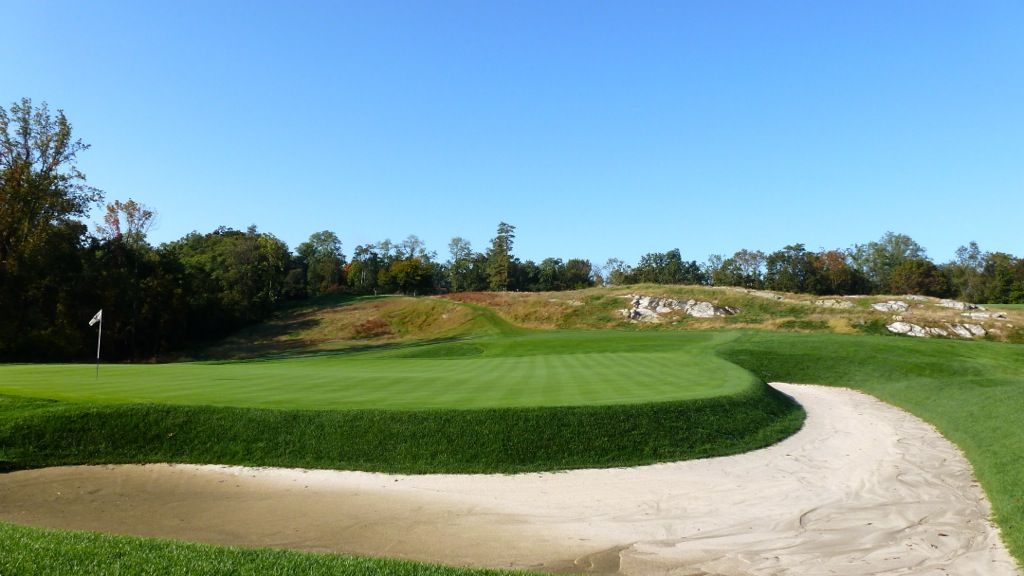
The 8th returns us to the parkland feel and the Tillinghast holes. Though I played the course after two-days of rain, the Macdonald holes played fairly firm. The Tillinghast holes from 8-12, however, played noticeably softer. Perhaps Macdonald was onto something when he chose to route his course away from the stream that runs through this stretch?
Though the 8th has a wide playing corridor, after the vast expanse of holes 2-7, one cannot help but feel constrained on this tee shot. Few can opt to hit less than driver as the hole plays over 460 yards, and a landform in the right-centre of the fairway lurks and may kick seemingly well-placed tee shots towards the rough.

The 9th is a very good golf hole. A diagonal ridge runs across the fairway's centre. Successfully challenge the landform on the shortest line and the golfer will have a clear look at the green but from a difficult angle.

The green is one of the two best on the course (the other is also a Tilley green). Unlike the contours on the 4th or 5th, which feel wholly manufactured, the 9th green drapes perfectly over the land.

The 10th hole, a 170 yard downhill par-3, will be singled out by many as it feels out of character with the rest of the course and is an altogether uninteresting hole. Still, it is a way to get from one side of the lake to the other and in no way is offensive. A connector hole.

The 11th returns the golfer to the trend of difficult Tilley par-4s with great greens. A new back tee at 433 yards has added 60+ yards to the hole, and though the wild green and deep greenside bunkering always ensured this hole would be no pushover, the hole's teeth have been restored. A bold tee shot down the right should result in a shorter approach to the green,

Though a narrow open green-front and a steep false-front mean that angle is of little importance.

The green's contours form something of a punchbowl as the left, rear and right edges of the green will collect shots towards its centre. An overall back-to-front tilt is noticeable.
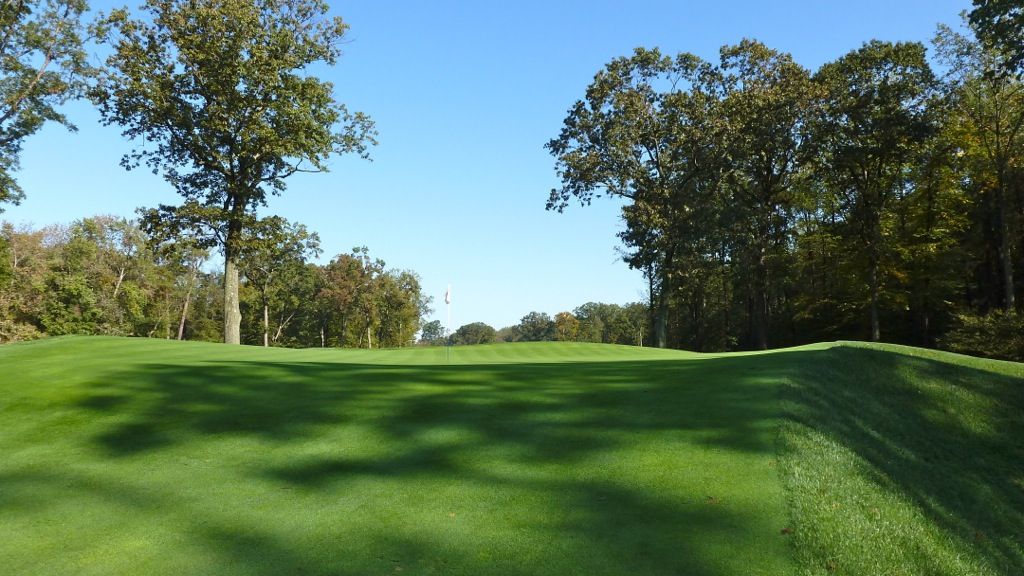
Missing left or long is not good.

The 12th hole is the most changed by Hanse and Bahto, converting it from a straightaway par-4 to a snaking, mid-length par-5 with a double-plateau green. The change not only alleviated the monotony (so some say) of so many par-4 holes, but it also shortened the transition to the 13th tee by some 150 yards.

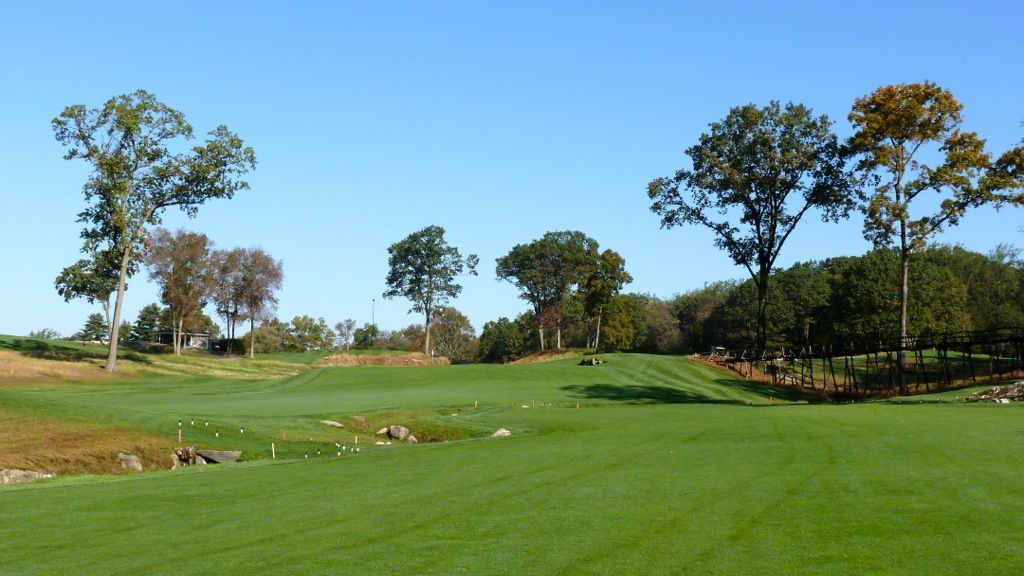

The 13th, a 394 yard par-4, returns the golfer to the Macdonald holes, and it's a really good one. The DZ is blind from the tee but the green is readily in view. Challenging a series of fairway bunkers down the left leaves a much simpler angle of approach into a green protected short-right by one of the deepest bunkers on the golf course.
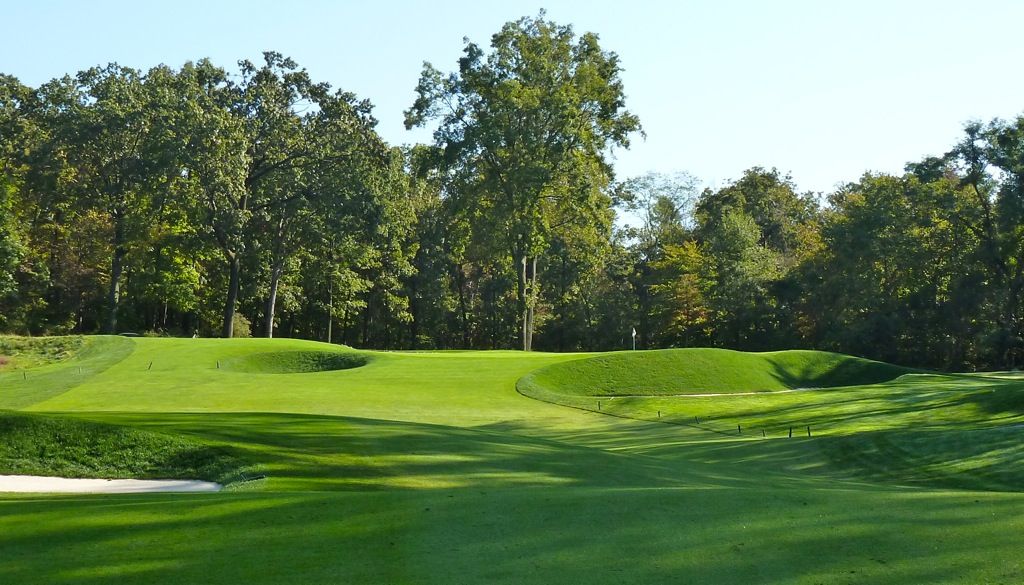
Routed alongside and in the opposite direction to the 14th, the two prevailing winds ensure that one of these two holes will play quite long (usually it is the 14th). A cross-bunker juts into the fairway 270 yards from the back tee, narrowing the fairway by 2/3. My playing partner suggested that this was excessive, as nearly all golfers able to reach the bunker will simply lay up to it.

There is no doubt that the golfer has a preferred view if he successfully challenges the cross-bunker, but the preferred angle is from the left, short of the bunker. No matter the angle, a precise approach is required as this as a very narrow green.

The 15th once played as a sub-500 yard par-5, but has since been modified to a soul-taking, into-the-wind and uphill 440 yard par-4.

Much like the punchbowls at National and Fishers Island, the approach to the green is completely blind.
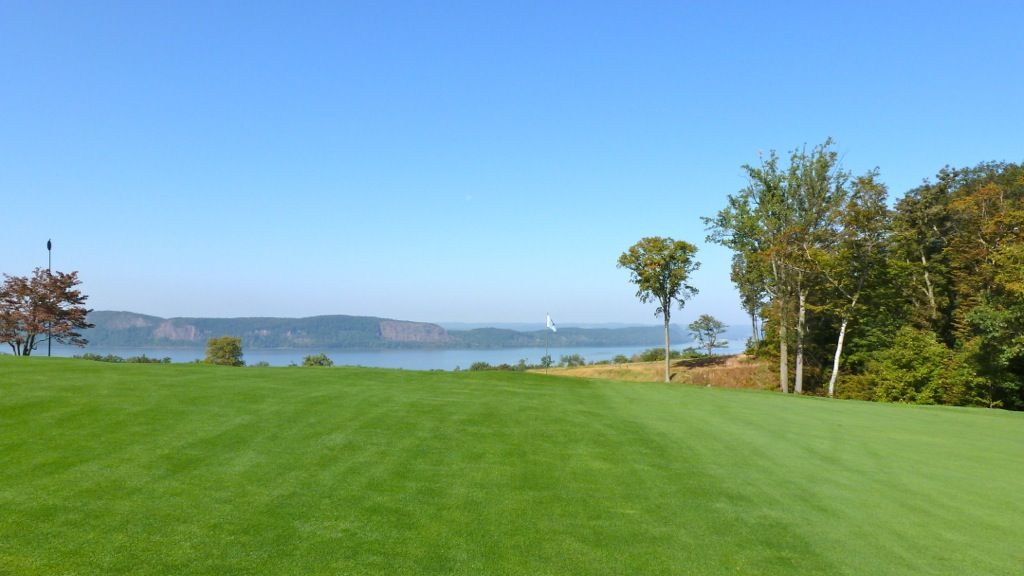

The Short has been restored to its former glory. The hole plays only 155 yards down the hill, and like the Short at Yale, is encircled by bunkers.

Unlike the other Short templates I've seen, this one does not feature a prominent 'thumbprint' in the green. The green is probably most comparable to the Short at National, with its wild and random contours contours.


The 17th hole at 446 yards, though expansive and difficult and with a great view, is not an overly interesting golf hole.
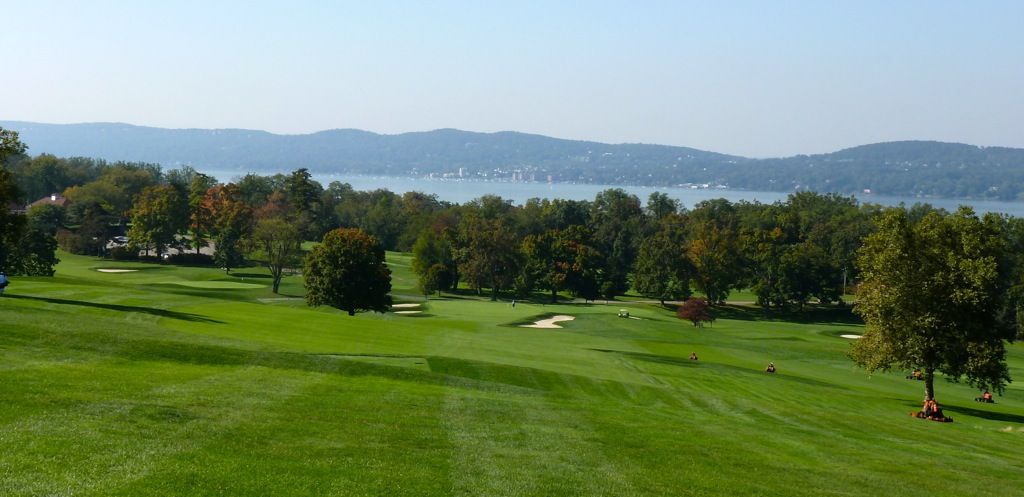
A back tee has been added to the 18th at 426 yards. The hole plays alongside the 1st and even more than that hole would benefit from a wider playing corridor -- I am not convinced that the current fairway width melds well with the fairway contouring and firm conditions.

My playing partner told me this bunker has been nicknamed Bahto's Bunker. I'm not sure why, but I know it's a bad place to be.
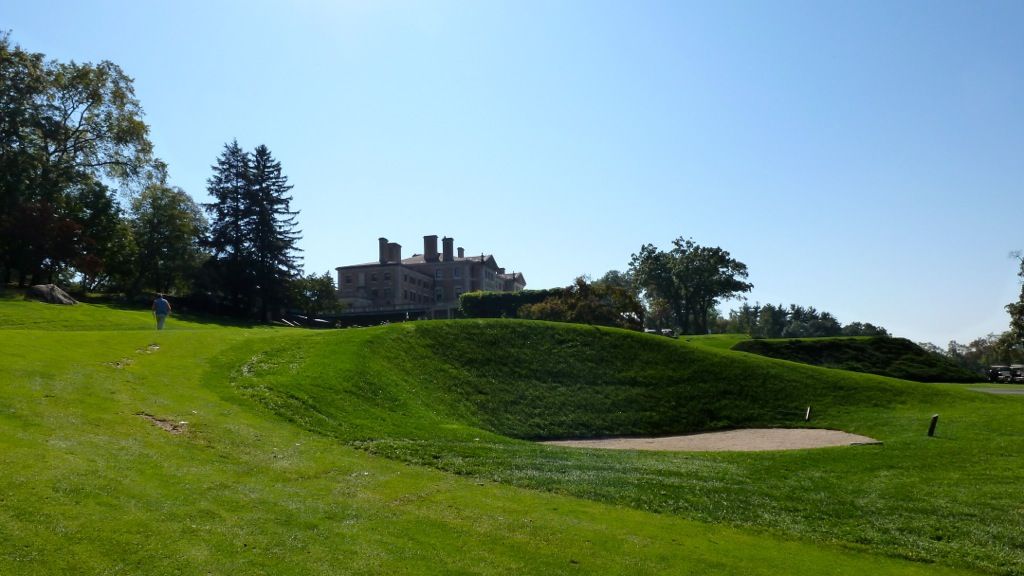

No comments:
Post a Comment